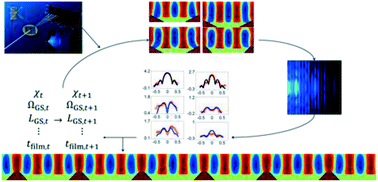当前位置:
X-MOL 学术
›
Mol. Syst. Des. Eng.
›
论文详情
Our official English website, www.x-mol.net, welcomes your feedback! (Note: you will need to create a separate account there.)
Optimizing self-consistent field theory block copolymer models with X-ray metrology†‡
Molecular Systems Design & Engineering ( IF 3.6 ) Pub Date : 2018-01-31 00:00:00 , DOI: 10.1039/c7me00098g Adam F Hannon 1 , Daniel F Sunday 1 , Alec Bowen 2 , Gurdaman Khaira 3 , Jiaxing Ren 2 , Paul F Nealey 2, 4 , Juan J de Pablo 2, 4 , R Joseph Kline 1
Molecular Systems Design & Engineering ( IF 3.6 ) Pub Date : 2018-01-31 00:00:00 , DOI: 10.1039/c7me00098g Adam F Hannon 1 , Daniel F Sunday 1 , Alec Bowen 2 , Gurdaman Khaira 3 , Jiaxing Ren 2 , Paul F Nealey 2, 4 , Juan J de Pablo 2, 4 , R Joseph Kline 1
Affiliation

|
A block copolymer self-consistent field theory (SCFT) model is used for direct analysis of experimental X-ray scattering data obtained from thin films of polystyrene-b-poly(methyl methacrylate) (PS-b-PMMA) made from directed self-assembly. In a departure from traditional approaches, which reconstruct the real space structure using simple geometric shapes, we build on recent work that has relied on physics-based models to determine shape profiles and extract thermodynamic processing information from the scattering data. More specifically, an SCFT model, coupled to a covariance matrix adaptation evolutionary strategy (CMAES), is used to find the set of simulation parameters for the model that best reproduces the scattering data. The SCFT model is detailed enough to capture the essential physics of the copolymer self-assembly, but sufficiently simple to rapidly produce structure profiles needed for interpreting the scattering data. The ability of the model to produce a matching scattering profile is assessed, and several improvements are proposed in order to more accurately recreate the experimental observations. The predicted parameters are compared to those extracted from model fits via additional experimental methods and with predicted parameters from direct particle-based simulations of the same model, which incorporate the effects of fluctuations. The Flory–Huggins interaction parameter for PS-b-PMMA is found to be in agreement with reported ranges for this material. These results serve to strengthen the case for relying on physics-based models for direct analysis of scattering and light signal based experiments.
中文翻译:

利用 X 射线计量优化自洽场论嵌段共聚物模型†‡
嵌段共聚物自洽场论 (SCFT) 模型用于直接分析由定向自洽材料制成的聚苯乙烯-b-聚甲基丙烯酸甲酯 (PS- b -PMMA) 薄膜获得的实验 X 射线散射数据。集会。与使用简单几何形状重建真实空间结构的传统方法不同,我们基于最近的工作,依赖基于物理的模型来确定形状轮廓并从散射数据中提取热力学处理信息。更具体地说,SCFT 模型与协方差矩阵适应进化策略 (CMAES) 相结合,用于查找最能再现散射数据的模型的模拟参数集。SCFT 模型足够详细,可以捕获共聚物自组装的基本物理原理,但又足够简单,可以快速生成解释散射数据所需的结构剖面。评估了模型产生匹配散射剖面的能力,并提出了一些改进措施,以便更准确地重新创建实验观察结果。将预测参数与通过附加实验方法从模型拟合中提取的参数以及来自同一模型的直接基于粒子的模拟的预测参数进行比较,其中包含波动的影响。发现 PS- b -PMMA的 Flory-Huggins 相互作用参数与该材料的报告范围一致。这些结果有助于加强依赖基于物理的模型来直接分析散射和基于光信号的实验的情况。
更新日期:2018-01-31
中文翻译:

利用 X 射线计量优化自洽场论嵌段共聚物模型†‡
嵌段共聚物自洽场论 (SCFT) 模型用于直接分析由定向自洽材料制成的聚苯乙烯-b-聚甲基丙烯酸甲酯 (PS- b -PMMA) 薄膜获得的实验 X 射线散射数据。集会。与使用简单几何形状重建真实空间结构的传统方法不同,我们基于最近的工作,依赖基于物理的模型来确定形状轮廓并从散射数据中提取热力学处理信息。更具体地说,SCFT 模型与协方差矩阵适应进化策略 (CMAES) 相结合,用于查找最能再现散射数据的模型的模拟参数集。SCFT 模型足够详细,可以捕获共聚物自组装的基本物理原理,但又足够简单,可以快速生成解释散射数据所需的结构剖面。评估了模型产生匹配散射剖面的能力,并提出了一些改进措施,以便更准确地重新创建实验观察结果。将预测参数与通过附加实验方法从模型拟合中提取的参数以及来自同一模型的直接基于粒子的模拟的预测参数进行比较,其中包含波动的影响。发现 PS- b -PMMA的 Flory-Huggins 相互作用参数与该材料的报告范围一致。这些结果有助于加强依赖基于物理的模型来直接分析散射和基于光信号的实验的情况。



























 京公网安备 11010802027423号
京公网安备 11010802027423号